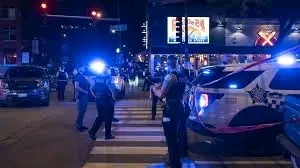Tragedy on the Coronado Bridge: Community Grieves After Latest Suicide Renews Urgent Calls for Action
On the evening of Saturday, July 5, 2025, San Diego was once again reminded of the haunting legacy surrounding one of its most iconic landmarks—the Coronado Bridge. The incident involved an individual who jumped from the bridge, resulting in a fatal outcome and leaving behind a wave of sorrow, concern, and urgent conversations about mental health and safety measures.
The bridge, stretching gracefully across the San Diego Bay, is a staple of the city’s skyline. Its sweeping views and elegant structure have long been a symbol of architectural beauty. But beneath its majestic arches lies a painful history—one that has grown heavier with each tragic incident. Saturday night’s events not only brought traffic to a standstill but also reignited a longstanding debate about the safety infrastructure and the mental health crisis plaguing the region.
A Disturbing Scene Unfolds
Witnesses who were crossing the bridge that evening described the sudden disruption as traffic came to an abrupt halt. Emergency vehicles lined the span, lights flashing against the dusky sky. Authorities quickly closed off lanes in both directions while first responders attempted to manage the situation.
According to initial reports, the individual stopped their vehicle mid-span and exited before climbing over the railing. Although emergency responders were dispatched swiftly—including the Coast Guard and a water rescue team—the incident unfolded too rapidly for intervention to occur in time.
The response team recovered the body from the bay shortly thereafter. Despite immediate lifesaving efforts, the individual was pronounced dead at the scene. As standard protocol, authorities have withheld the identity of the deceased pending family notification.
Ripple Effects: Emotional and Logistical Impact
The incident triggered more than just a temporary inconvenience for drivers. Social media was quickly flooded with photos and videos from those stuck on the bridge, many expressing their shock and sorrow. The temporary shutdown caused delays that lasted for several hours, stranding hundreds and diverting countless more. Yet, the human toll far outweighed the traffic frustrations.
Witnesses who saw the event unfold have spoken of their emotional distress, with several drivers and pedestrians describing feelings of helplessness and heartbreak. “You never expect to see something like that happen in front of you,” one motorist shared online. “I couldn’t stop thinking about what that person must have been going through.”
Mental health advocates emphasize that such reactions are not uncommon. Traumatic events—even when witnessed from a distance—can leave lasting emotional scars, particularly for those who may already be struggling with their own challenges.
The Bridge’s Troubling History
The Coronado Bridge, officially known as the San Diego–Coronado Bay Bridge, opened to the public in 1969. Spanning more than 2 miles in length and standing 200 feet above the water at its highest point, the bridge was never originally designed with suicide deterrents in mind. Over the decades, it has sadly become one of the more frequent sites for such tragedies in the state of California.
According to data compiled by local mental health organizations, hundreds of lives have been lost on the bridge since its opening. While safety upgrades such as higher railings and video monitoring have been proposed repeatedly, bureaucratic delays and budget constraints have often impeded progress.
In 2019, the California Department of Transportation (Caltrans) launched a feasibility study on installing suicide deterrent barriers along the span. The study cited options such as vertical fencing or netting—similar to those installed on the Golden Gate Bridge in San Francisco. However, implementation has lagged behind due to structural complexities and financial challenges.
Saturday’s tragedy once again puts the spotlight on the pressing need for preventative measures.
A Community Demanding Change
The most recent incident has reignited passionate pleas from residents, advocacy groups, and mental health professionals for immediate action. Organizations like the Bridge Collaborative for Suicide Prevention, which have been advocating for structural deterrents for years, expressed heartbreak at yet another life lost.
“This is not just a statistic—it’s a person with a story, with loved ones, with a future that will never be realized,” a spokesperson for the group said. “We cannot keep delaying action. The time for preventative infrastructure is long past due.”
City leaders have also weighed in. San Diego’s mayor released a statement expressing condolences and emphasizing the administration’s commitment to supporting initiatives that address both mental health resources and public safety infrastructure. “Every life lost to suicide is a tragedy that affects the entire community,” the statement read. “We must do more—together—to prevent these devastating moments.”
The Mental Health Crisis in Focus
Beyond the physical structure of the bridge lies a deeper crisis—one that stretches across communities nationwide. Mental health professionals point out that suicide is often the final, desperate act of individuals suffering from intense emotional, psychological, or social turmoil.
Dr. Evelyn Morado, a licensed clinical psychologist in San Diego, noted the importance of creating comprehensive solutions. “We have to treat this as the multifaceted issue it is,” she said. “It’s about infrastructure, yes, but it’s also about access to mental health services, reducing stigma, early intervention, and community education.”
Statistics from the San Diego County Health and Human Services Agency show an uptick in calls to mental health crisis lines in recent years, particularly following the COVID-19 pandemic. Young adults, veterans, and marginalized communities are among the most vulnerable populations.
Efforts to expand community-based mental health care—including mobile crisis units and partnerships with local nonprofits—have seen positive outcomes. But demand often outpaces availability, leaving many without the help they need in their darkest moments.
Loved Ones Left Behind
While the identity of the person who jumped has not been made public, it is certain that behind this loss is a circle of loved ones now grappling with profound grief. Friends, family members, and coworkers will be left to navigate a painful path forward, often haunted by questions and guilt that may never find answers.
Survivors of suicide loss often experience a complex mix of sorrow, anger, confusion, and regret. Support groups, both in-person and virtual, have become essential lifelines for those left behind. Organizations like Survivors of Suicide Loss (SOSL) San Diego provide peer-led groups and resources tailored to families mourning these sudden and tragic departures.
“Grief from suicide is different,” said one local facilitator. “It can feel isolating because of the stigma and the unanswered questions. But nobody has to go through it alone. Support is out there.”
Media Responsibility and Ethical Coverage
The incident also raised questions about how such tragedies are reported and discussed in public discourse. Mental health experts caution that sensationalized reporting or explicit details can contribute to contagion effects, especially for vulnerable individuals.
Responsible reporting guidelines—such as avoiding graphic descriptions, emphasizing resources for help, and focusing on hope and recovery—are vital. Local news outlets and community organizations have made an effort to follow these principles, aiming to honor the person’s life while raising awareness about the broader issue.
Resources and Hope
In the wake of this tragedy, community leaders and mental health advocates continue to emphasize one crucial message: help is available. Local hotlines, national lifelines, text-based services, and walk-in crisis centers remain accessible around the clock for anyone experiencing distress.
The National Suicide Prevention Lifeline (now part of the 988 Suicide & Crisis Lifeline) can be reached simply by dialing 988—a service available 24/7 and staffed by trained counselors.
San Diego County residents also have access to local mental health centers and crisis intervention teams who can respond to urgent situations and provide guidance, therapy referrals, or emergency support.
Above all, those who are struggling are urged to remember: there is no shame in seeking help. Life can feel unbearably heavy at times, but support systems exist, and recovery is possible.
A Shared Responsibility
As the community processes the sorrow of Saturday’s loss, it is clear that the Coronado Bridge stands not just as a feat of engineering, but also as a symbol of a critical societal crossroads. The pain felt across San Diego is a call to action—a call for compassion, for understanding, for resources, and for change.
It is a shared responsibility, from lawmakers to neighbors, from school counselors to transit authorities. Preventing future tragedies will require ongoing commitment and collaborative solutions. Infrastructure improvements, increased access to mental health care, education campaigns, and destigmatizing mental illness must all be part of the collective path forward.
As one San Diegan wrote in a tribute shared online, “Let this not be just another tragedy we mourn and forget. Let this be the moment we finally say: no more.”
If you or someone you know is in emotional distress or experiencing thoughts of suicide, please call or text the Suicide & Crisis Lifeline at 988. Help is free, confidential, and available 24/7.




